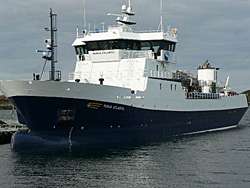Much to gain by optimizing delousing

New research shows that the efficacy of delousing efforts is greatly affected by the materials used in constructing a well boat’s tank for mixing the delousing agent. This knowledge has now led to improvements in conventional delousing methods.
Developing and optimising new treatment methods is a key objective of the Research Council of Norway’s efforts to combat sea lice. The three-year research project A multi-disciplinary effort to improve topical treatments in salmon louse control (Topilouse) was launched in 2010 to optimise the delousing treatment of salmon in sea cages and well boats.
“By optimizing the treatment methods, we can combat the sea lice problem more effectively with the same agents we currently use,” asserts Senior Researcher Peter Andreas Heuch of the National Veterinary Institute.
Choice of materials is critical
Norway’s fleet of well boats comprises many types of vessels employing highly diverse practices for changing out the water in their wells. This makes it challenging to control the amount of delousing agent to which the fish in the well are exposed. The wrong choice of materials on board can, in the worst case, lead to lice developing resistance to delousing agents.
“The delousing agent is added into a mixing tank before being released into the water current or directly into the well,” explains Dr. Heuch. “In mixing tanks made of plastic, the pyrethroids (a group of active ingredients commonly used in delousing agents) stick to the tank wall, which lowers the concentration of agent too much to adequately delouse the fish. This may have contributed to incorrect conclusions about resistance in lice.”
“At the same time, we know that repeated treatments with insufficient concentrations can indeed be a factor in promoting such resistance.”
Pyrethroids affix least to glass, but steel mixing tanks are also preferable to plastic ones.
Justifiable ban against “skirts”
In January 2011 a ban on the use of skirts (partial-coverage tarpaulins around sea cages) during delousing in the cage was introduced. The project researchers analysed how delousing agents are dispersed in salmon cages and documented that the ban is warranted.
“The use of a skirt allows the current beneath the sea cage to flow up into the cage, which dilutes the delousing agents added,” confirms Dr. Heuch.
.jpg)
A full tarpaulin makes it easier to achieve and maintain the necessary concentration of therapeutant during delousing treatment. Trials in 12-m-diameter cages have substantially enhanced the researchers’ understanding of the fishes’ role in uniformly dispersing the therapeutant. Beforehand, the researchers had assumed that the air bubble stream from the oxygenator used for enclosed delousing would be an important factor in dispersing the active ingredient properly. But the trials revealed that this was far less significant than believed; it turns out the salmon themselves can create a strong current inside the tarpaulin, taking care of the mixing in the process.
Project participants Erik Høy of SINTEF Fisheries and Aquaculture and Frode Oppedal of the Institute of Marine Research report that good dispersion was achieved within minutes of adding the therapeutant into the experimental cage.
Full-scale testing
In autumn 2012 similar trials will be conducted in full-scale cages, employing a specially designed DNA molecule as a marker to be released into the delousing cage. This will tell the researchers the concentrations of marker at various points within the cage. These data will help to confirm that the delousing agent is distributed just as symmetrically under commercial conditions as it is on an experimental scale, which will be valuable for developing modelling tools to be used in establishing new dosing methods and in optimizing delousing operations.
Seven tips for measuring efficacy
Based on its analysis of databases of sea lice counts, the Topilouse project has these preliminary tips for assessing the efficacy of delousing bath treatments at aquaculture facilities:
• Count the lice on 25 fish specimens from each cage, then on 25 fish after treatment.
• Capture the fish in the same way each time, using a knotless sampling net or landing net.
• Select fish that are fairly similar in size; it is simplest to take fish of average size (±25%).
• Record separate counts for attached, pre-adult and adult lice, as well as the smaller, lighter-coloured Caligus elongatus lice.
• Start treatment no later than one week after counting, preferably after three days.
• Counting, post-treatment: when recommended by the delousing agent producer, but preferably 4-10 days after treatment when water temperature is above 10°C.
• When colder than this, repeat the count after three weeks.
• Record all data relevant to assessing the treatment: the delousing agent, its concentration in the water, volume of water treated, duration of treatment (from the addition of therapeutant until the tarpaulin is opened), water temperature and salinity, content of oxygen and any additives, current speed, and any technical problems.
To achieve acceptable results, treatment efficacy must exceed 80 per cent for every cage.
Provided by The Research Council of Norway

















